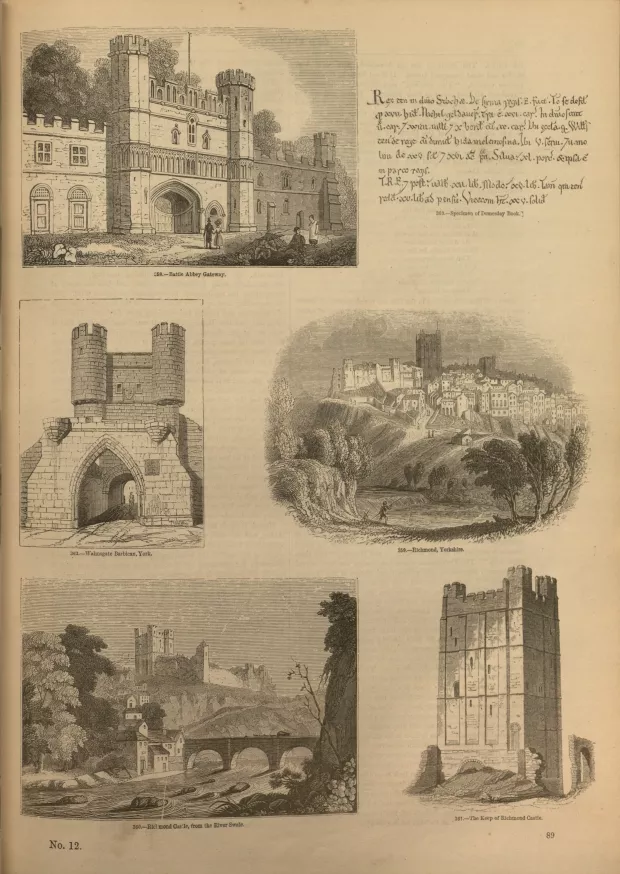Height
9 cm
Width
14 cm
Medium
Genre
Description
In Passages from the Life of Charles Knight—the abridged, American version of Knight’s three-volume autobiography, Passages of a Working Life during Half a Century: with a Prelude of Early Reminisces—Knight describes his “awakening feeling for the preservation of our historical monuments,” intending to fire a similar appreciation in working class citizens (429). In contrast with the other views of Richmond and its castle in this plate, this scenic perspective invites the viewer to imagine him or herself viewing the castle from the banks of the Swale River. William Gilpin similarly intended his tours of various parts of the British Isles to be accessible to all. Kim Michisaw interprets Gilpin's use of landscapes as an attempt to give the viewer entry into the illusionistic, picturesque spaces of images (84-86).
Eighteenth-century England sought to unite the diverse peoples of the British Isles by drawing upon a common historical heritage. Anne Janowitz notes how British national identity became intricately associated with nature itself: the physical remains of centuries-old architecture in the British countryside were seen as tangible evidence of a common history and thus of contemporary political unity. Furthermore, the picturesque aesthetic which developed later in the century glorified decayed structures from the medieval period because they had been subsumed into the land: stained, overrun, and rent by insects and vegetation (Ruskin qtd. in Lowenthal: 157). Consequently, in that medieval ruins were associated with the picturesque qualities of the British countryside and were identified as markers of historical continuity, inculcating an appreciation of these ruins in the masses seemed an ideal way to unify and educate them.
Knight’s article in the London Magazine clarified his opinion regarding the need “to provide adequate excitements, and reasonable gratifications, for the intellectual activity of the working classes” and their children (Education of the People 3). The sciences, history, and geography were the primary subjects of focus. But the arts featured prominently as well, evidenced by his frequent inclusion of copies of artworks from antiquity and contemporary times. These art objects were often used as illustrations for moral lessons (Anderson, Pictures for the People 137). Although these publications did participate in a general, reform movement mentality which sought (in the 1830s and '40s) to quell the civil unrest among the working classes by means of education, they reflect a more prominent goal for Knight. This goal aimed at the transmission of “one of art's central traditions: that body of thought which equated art with moral elevation and advanced civilization, and artists with virtue and industriousness” (Anderson, Pictures for the People 137).
Knight’s collection of engravings and commentary on the “Antiquities [sic] of a great Nation” described the “richest treasures that we have derived from a long line of ancestors” (Old England 1). Originally issued in parts and available to “all ranks of people, at the cheapest rate," Knight’s publication participated in the “education of the people” by reinforcing Romantic notions of the elevated status of the arts (Old England 1): the volume specifically encouraged the idea of drawing as a polite and useful art for all classes, and also implicitly emphasized and contributed to the construction of political unity via a knowledge of history (Bermingham 77-78).
In this image, situated in the bottom left corner of the page, Richmond Castle is perceived from an enchanting spot along the River Swale. While highlighting the link between a knowledge of the history of medieval Britain and the construction of political unity, this view introduces the element of domestic tourism, a popular pastime of the Romantic period.
360.—Richmond Castle, from the River Swale, placed in the bottom left corner of page eighty nine, depicts the castle as seen from the banks of the Swale river. A bridge extends from the right side of the image over a smoothly flowing river; a small village of white, peak-roofed houses sits on the left bank, and continues up the hill to the distant castle. The hill is accented with shrubs and tall trees. Richmond Castle itself boasts one large, intact tower, while the rest of the towers and walls appear to be in advanced stages of decay.
Associated Works
Copyright
Copyright 2009, Department of Special Collections, Memorial Library, University of Wisconsin-Madison, Madison, WI
Publisher
Charles Knight
Collection
Additional Information
Bibliography
Editorial Responsibility, in the Matter of "Old England": Being Three Letters Published in the Athenaeum, and Mr. Knight's Comments thereupon. 1867. Cowen Tracts. JSTOR. Web. 30 Mar. 2009.
Anderson, Patricia J. “Charles Knight and Company.” British Literary Publishing Houses, 1820-1860. Dictionary of Literary Biography. Anderson and Jonathan Rose, eds. Vol. 106. Detroit: Gale Research, 1991. Print.
---. “Pictures for the People: Knight's 'Penny Magazine,' an Early venture into Popular Art Education.” Studies in Art Education 28.3 (1987): 133-40. Print.
---. The Printed Image and the Transformation of Popular Culture, 1790-1860. Oxford: Clarendon P; New York: Oxford UP, 1991. Print.
Bermingham, Ann. Learning to Draw: Studies in the Cultural History of a Polite and Useful Art. New Haven: Yale UP, 2000. Print. The Paul Mellon Centre for Studies in British Art.
Janowitz, Anne F. England's Ruins: Poetic Purpose and the National Landscape. Cambridge: Blackwell. 1990. Print.
Knight, Charles. "Education of the People." The London magazine 1.1 (1828): 13. ProQuest. Web. 1 Apr. 2009.
---. Passages from the Life of Charles Knight. New York, 1874. Making of America. Ann Arbor: U of Michigan Library, 2005. Web. 9 April 2009.
---. Old England: A Pictorial Museum of Regal, Ecclesiastical, Municipal, Baronial, and Popular Antiquities. London: Sangster, 185-. Print.
Lowenthal, David. The Past is a Foreign Country. Cambridge: Cambridge UP, 1985. Print.

